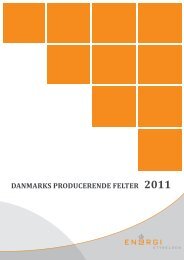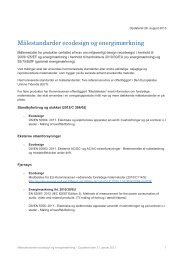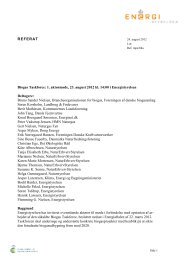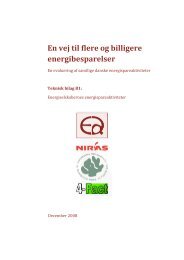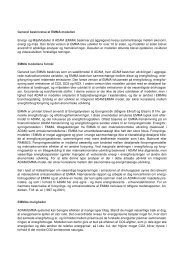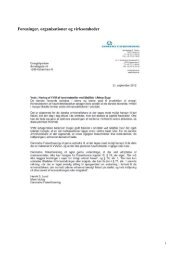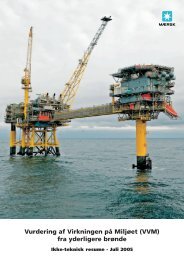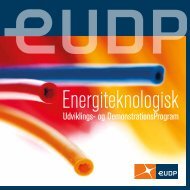Energy Strategy 2050 – from coal, oil and gas
Energy Strategy 2050 – from coal, oil and gas
Energy Strategy 2050 – from coal, oil and gas
Create successful ePaper yourself
Turn your PDF publications into a flip-book with our unique Google optimized e-Paper software.
Initiatives in the strategy<br />
32<br />
Background The government will<br />
An increased expansion of wind power<br />
To the extent that suitable locations can be found,<br />
onshore wind turbines are far cheaper than offshore<br />
wind turbines <strong>and</strong> most other RE technologies. Due to<br />
technological development <strong>and</strong> rising electricity prices, it<br />
is expected that wind power in the long term will be able<br />
to compete with conventional electricity production, <strong>and</strong><br />
that subsidies for onshore wind turbines can therefore<br />
gradually be phased out.<br />
The majority of existing onshore turbines are more than<br />
ten years old <strong>and</strong> will most likely be scrapped before<br />
2020. The need to designate more locations suitable for<br />
new <strong>and</strong> larger turbines is therefore great. In order to<br />
cater for the technological development of new turbines,<br />
it will also be necessary to designate suitable l<strong>and</strong> where<br />
the wind turbine industry can test <strong>and</strong> demonstrate new<br />
turbines.<br />
Future wind turbines will increasingly have to be placed<br />
offshore, since there are only a limited number of suitable<br />
locations available onshore. The potential for offshore<br />
wind turbines is huge in Denmark. In order to promote<br />
technological development of offshore wind turbines, it is<br />
necessary, that newly developed turbines can be erected<br />
<strong>and</strong> operated on a continuous basis, preferably closer<br />
to the coast than previously. This will also provide opportunities<br />
for the general public, private organisations,<br />
municipalities etc. to be involved in the projects.<br />
<strong>Energy</strong> <strong>Strategy</strong> <strong>2050</strong> <strong>–</strong> <strong>from</strong> <strong>coal</strong>, <strong>oil</strong> <strong>and</strong> <strong>gas</strong> to green energy.<br />
• Call for tenders for a 600MW offshore wind farm at<br />
Kriegers Flak. Kriegers Flak can be realised as a joint<br />
project between Denmark <strong>and</strong> Germany (<strong>and</strong> possibly<br />
also Sweden) with expected operationalisation<br />
2018-2020<br />
• Call for tenders for smaller offshore wind turbine<br />
installations totalling 400MW closer to the coast<br />
than current wind farms. This will enable testing <strong>and</strong><br />
demonstration of new turbines, foundations etc., as<br />
well as sites for conventional wind mills, up to 2020.<br />
Suitable locations will be found through a screening<br />
process<br />
• Improve tendering procedures for offshore wind<br />
farms to reduce the costs of expansion <strong>and</strong> prepare<br />
the basis for offshore wind turbine expansion decisions<br />
in the period after 2020<br />
• As part of a general analysis of subsidy systems examine<br />
how subsidies for onshore turbines <strong>from</strong> 2014<br />
can be designed most appropriately, so that they are<br />
adjusted to rising electricity prices <strong>and</strong> technological<br />
development<br />
• Support continued municipal planning for new onshore<br />
wind turbines <strong>and</strong> at the same time look more<br />
closely at planning tools for onshore wind turbines.<br />
Up to 2020, in combination with other external conditions,<br />
this is expected to contribute to new turbines<br />
totalling a capacity of 1800MW. This is 500MW more<br />
than expected so far<br />
• Analyse the opportunities for reducing the distance<br />
requirements for wind turbines placed along roads<br />
<strong>and</strong> railways with a view to better use of locations in<br />
such areas<br />
• Commission a strategic environmental assessment<br />
with a view to both call for tenders on nine<br />
state-owned l<strong>and</strong> plots for the erection of onshore<br />
wind turbines, <strong>and</strong> to assist municipalities with wind<br />
turbine planning<br />
• Designate l<strong>and</strong> for testing prototypes <strong>and</strong> ‘series 0’<br />
wind turbines<br />
• In cooperation with industry, continue the wind<br />
turbine secretariat, including the mobile wind turbine<br />
task force, which assists municipalities with wind<br />
turbine planning.




